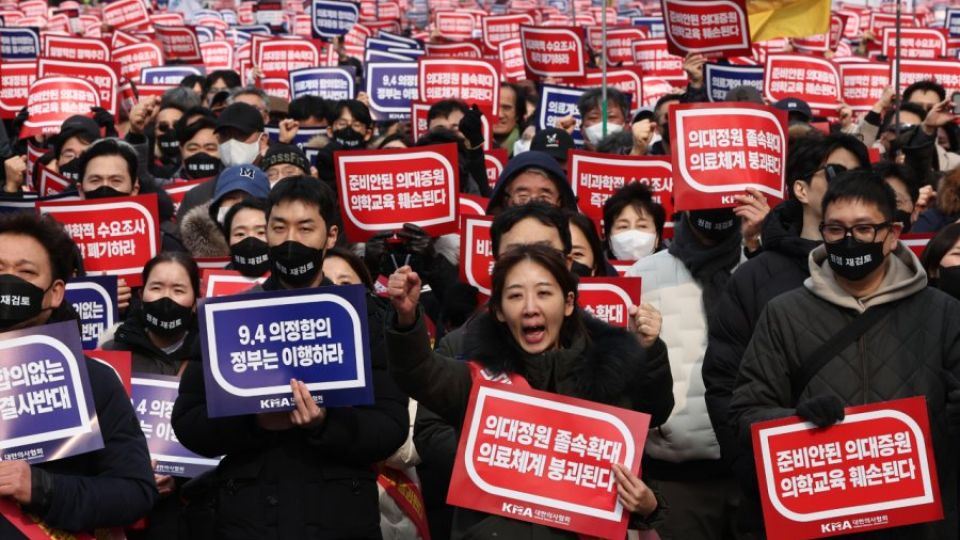March 4, 2024
SEOUL – Tensions between the Yoon Suk Yeol government and the medical community have escalated to a boiling point, with doctors flooding the streets in a massive protest on Sunday, defying the government’s ultimatum to return to work by Thursday or face legal consequences.
At the Yeouido Hangang Park in western Seoul, doctors, interns, residents and medical students staged a large-scale protest to denounce the government’s decision to increase the annual medical school student enrollment quota by 2,000 from next year.
The street protest marked the culmination of a nearly month-long conflict between the government and the medical community over the issue, with no signs of the gap between the two sides narrowing.
“If the government ignores the efforts of doctors and tries to suppress them, it will face strong public resistance,” said Kim Taek-woo, chairman of the Emergency Response Committee of the Korean Medical Association, the country’s largest doctors’ organization.
“The government unilaterally promoted policies that doctors would never accept in the name of ‘health care reform.’”
The KMA said around 40,000 people were estimated to have participated in the rally, while the police estimated the figure to be between 8,500 and 9,000.
The protest unfolded days after Feb. 29, the deadline originally set by the Yoon government for trainee doctors to resume work without facing legal consequences.
During a press briefing on Feb. 26, the Ministry of Health and Welfare warned that “legal procedures, such as suspending licenses for a minimum of three months, conducting investigations and initiating prosecutions, would be inevitable for individuals who have not returned to work in March.”
The South Korean government immediately responded to the mass rally, the first of its kind since the government’s announcement of its quota hike plans.
Prime Minister Han Duck-soo on Sunday criticized the fact that most trainee doctors have not returned to work, despite three days having passed since the government made the order.
During a meeting at the Central Disaster and Safety Countermeasures headquarters, Han emphasized that “the government’s stance remains unchanged.”
“If the situation of illegally vacating medical sites persists, the government will unhesitatingly fulfill its obligations bestowed by the constitution and laws,” Han stated.
“Regardless of the reasons, any act of turning away from patients by doctors cannot be tolerated.”
Interior and Safety Minister Lee Sang-min stated during his interview with KBS on Sunday that the government “would offer as much leniency as possible for trainee doctors to return by today.” Lee warned, “If they do not return by today, it is the government’s basic stance to have to take strict measures as per the law.”
Due to the prolonged joint strike, the government has intensified pressure against the striking doctors.
Seoul Metropolitan Police Agency Commissioner Cho Ji-ho also announced Sunday that the police had requested travel bans for current KMA executives who were targeted in the raids on Friday.
The police conducted raids on the office of the KMA as well as the homes of five current and former KMA executives. Additionally, the offices of the Seoul Medical Association and the Gangwondo Medical Association were targeted in the operation.
The KMA on Friday reacted with anger, saying, “We are incredibly outraged by the government’s suppression of doctors’ freedom and human rights,” in a statement.
The Ministry of Health and Welfare on Friday also issued a public notice to 13 doctors, some of whom have been vocal about a doctors’ walkout, urging them to return to work to avoid legal penalties.
The notice also stipulates that individuals who refuse the order without justifiable reasons could face disciplinary action and criminal charges in accordance with the Medical Service Act.
According to the ministry, there was an overwhelmingly high percentage of trainee doctors who hadn’t returned to their positions as of 5 p.m. on Feb. 29.
Among the 100 hospitals where 95 percent of South Korea’s trainee doctors are stationed, only 6 percent, totaling 565 doctors, had returned to their positions, while 71.8 percent, or 8,945 doctors, remained part of the joint strikes.
It’s assumed that more doctors have returned to their positions over the weekend since Friday, though exact numbers haven’t been revealed.
Starting Monday, the Health Ministry plans to conduct a field investigation to see which doctors did not return to work and pursue legal procedures according to the Administrative Procedures Act.
Monday marks the government’s deadline for universities to submit requests to expand student enrollment quotas for their medical schools.
According to an exclusive report by South Korean news outlet Newsis, seven out of 40 medical schools plan to submit proposals on Monday to increase their medical school enrollment, ranging from increases of at least 35 percent to three times the current capacity.
However, a number of medical school students have submitted a leave of absence to protest the government’s decision to increase the medical school student quota.
As of Saturday, 5,385 students had their leave of absence request accepted as valid, constituting 28.7 percent of the total student population across 40 medical schools nationwide.
Meanwhile, the World Medical Association, which is the international organization representing physicians, released an official statement on Friday, saying that it “stands in support” of the KMA.
“The government’s unilateral decision to drastically increase medical student admissions, implemented without clear evidence, has led to turmoil in the medical community,” said the WMA. “The right to collective action is universal, and guidelines are in place to ensure patient safety remains paramount during any collective action taken by physicians.”


